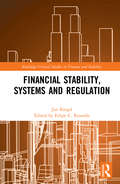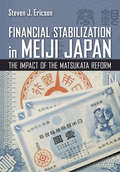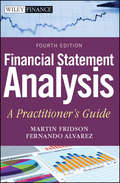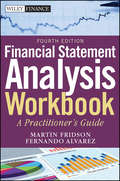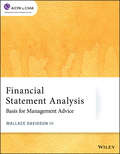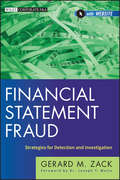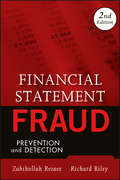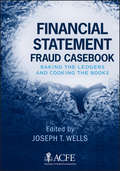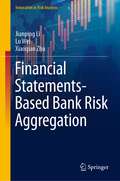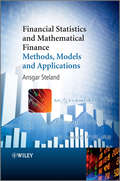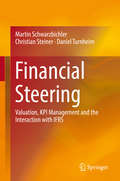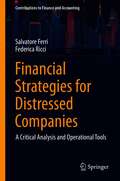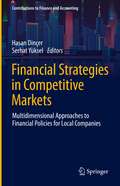- Table View
- List View
Financial Stability, Systems and Regulation (Routledge Critical Studies in Finance and Stability)
by Jan KregelEver since the 2007–8 global financial crisis and its aftermath, Hyman Minsky’s theory has never been more relevant. Throughout his career, Jan Kregel has called attention to Minsky’s contributions to understanding the evolution of financial systems, the development of financial fragility and instability, and designing the financial structure necessary to support the capital development of the economy. Building on Minsky, Kregel developed a framework to analyze how different financial structures develop financial fragility over time. Rather than characterizing financial systems as market-based or bank-based, Kregel argued that it is necessary to distinguish between the risks that are carried on the balance sheets of banks and other financial institutions. This volume, brought together by Felipe C. Rezende, highlights these major contributions from Kregel through a collection of his influential papers from various journals and conferences. Kregel’s approach provides a strong theoretical background to understand the making and unfolding of the crisis and helps us to draw policy implications to improve financial stability, and suggest an alternative financial structure for a market economy. In this book, his knowledge is consolidated and the ideas he puts forward offer a path for future developments in economics which will be of great interest to those studying and researching in the fields of economics and finance.
Financial Stabilization in Meiji Japan: The Impact of the Matsukata Reform (Cornell Studies in Money)
by Steven J. EricsonWith a new look at the 1880s financial reforms in Japan, Steven J. Ericson's Financial Stabilization in Meiji Japan overturns widely held views of the program carried out by Finance Minister Matsukata Masayoshi. As Ericson shows, rather than constituting an orthodox financial-stabilization program—a sort of precursor of the "neoliberal" reforms promoted by the IMF in the 1980s and 1990s—Matsukata's policies differed in significant ways from both classical economic liberalism and neoliberal orthodoxy.The Matsukata financial reform has become famous largely for the wrong reasons, and Ericson sets the record straight. He shows that Matsukata intended to pursue fiscal retrenchment and budget-balancing when he became finance minister in late 1881. Various exigencies, including foreign military crises and a worsening domestic depression, compelled him instead to increase spending by running deficits and floating public bonds. Though he drastically reduced the money supply, he combined the positive and contractionary policies of his immediate predecessors to pull off a program of "expansionary austerity" paralleling state responses to financial crisis elsewhere in the world both then and now.Through a new and much-needed recalibration of this pivotal financial reform, Financial Stabilization in Meiji Japan demonstrates that, in several ways, ranging from state-led export promotion to the creation of a government-controlled central bank, Matsukata advanced policies that were more in line with a nationalist, developmentalist approach than with a liberal economic one. Ericson shows that Matsukata Masayoshi was far from a rigid adherent of classical economic liberalism.
Financial Statecraft: The Role of Financial Markets in American Foreign Policy
by Benn Steil Robert E. LitanAs trade flows expanded and trade agreements proliferated after World War II, governments--most notably the United States--came increasingly to use their power over imports and exports to influence the behavior of other countries. But trade is not the only way in which nations interact economically. Over the past two decades, another form of economic exchange has risen to a level of vastly greater significance and political concern: the purchase and sale of financial assets across borders. Nearly $2 trillion worth of currency now moves cross-border every day, roughly 90 percent of which is accounted for by financial flows unrelated to trade in goods and services--a stunning inversion of the figures in 1970. The time is ripe to ask fundamental questions about what Benn Steil and Robert Litan have coined as "financial statecraft," or those aspects of economic statecraft directed at influencing international capital flows. How precisely has the American government practiced financial statecraft? How effective have these efforts been? And how can they be made more effective? The authors provide penetrating and incisive answers in this timely and stimulating book.
Financial Statement Analysis
by Martin S. Fridson Fernando AlvarezAn updated guide to the essential discipline of financial statement analysisIn Financial Statement Analysis, Fourth Edition, leading investment authority Martin Fridson returns with Fernando Alvarez to provide the analytical framework you need to scrutinize financial statements, whether you're evaluating a company's stock price or determining valuations for a merger or acquisition.This fully revised and up-to-date Fourth Edition offers fresh information that will help you to evaluate financial statements in today's volatile markets and uncertain economy, and allow you to get past the sometimes biased portrait of a company's performance.Reflects changes in the financial reporting landscape, including issues related to the financial crisis of 2008-2009Provides guidelines on how to interpret balance sheets, income statements, and cash flow statementsOffers information for maximizing the accuracy of forecasts and a structured approach to credit and equity evaluationFilled with real-life examples and expert advice, Financial Statement Analysis, Fourth Edition will help you gain a firm understanding of the techniques that will help you interpret financial statements, which are designed to conceal more than reveal.
Financial Statement Analysis Workbook: A Practitioner's Guide (Wiley Finance #599)
by Martin S. Fridson Fernando AlvarezAll too often, financial statements conceal more than they reveal. Even after the recent economic crisis, those analyzing financial statements face serious new concerns and challenges. The Fourth Edition of Financial Statement Analysis skillfully puts this discipline in perspective, and now, with this companion Workbook, you can hone your skills and test the knowledge you've gained from the actual text, before putting them to work in real-world situations. Question-and-answer sections within this Workbook correspond to each chapter of Financial Statement Analysis, Fourth Edition. Part One (Questions) provides chapter-by-chapter fill-in-the-blank questions, as well as financial statement and computational exercises. They are designed to be thought-provoking and require analysis and synthesis of the concepts covered in the book. The answers to all questions, which can be found in Part Two, are provided in boldfaced italic type in order to facilitate the checking of answers and comprehension of material. By enhancing your understanding of financial statement analysis, you can begin to undertake genuine, goal-oriented analysis and prepare for the practical challenges of contemporary business. This reliable resource will help you achieve such a difficult goal and allow you to make more informed decisions—whether you're evaluating a company's stock price or determining valuations for a merger or acquisition.
Financial Statement Analysis Workbook: A Practitioner's Guide (Wiley Finance #79)
by Martin S. Fridson Fernando AlvarezThe helpful workbook to help practice assessing financial statements Financial statement analysis is essential as part of any well-organized financial portfolio. As a companion piece, Financial Statement Analysis Workbook: A Practitioner's Guide allows readers the opportunity to test and hone the skills put forward in Martin Fridson and Fernando Alvarez's Financial Statement Analysis, a resource devoted to providing the analytical framework necessary to make sense of the sometimes misleading numbers put forth by companies. Scrutinizing financial statements allows one to, for example, evaluate a company&’s stock price or determine merger or acquisition valuations. The Financial Statement Analysis Workbook, then, provides a pathway to become familiar with these methodologies in order to be prepared to use them in real-world scenarios. With the skills provided within, you can begin to undertake goal-oriented preparation for the practical challenges of contemporary business, and feel confident in your financial decision-making. This is aided by: Question-and-answer sections within this Workbook correspond to each chapter of Financial Statement Analysis Financial statement and computational exercises designed to require analysis and synthesis of concepts covered in the core text A full list of answers in the second half of the book that help explain pitfalls within the questions An essential tool for professional analysts, investors, and students, Financial Statement Analysis Workbook offers the perfect opportunity to help turn theory into reality.
Financial Statement Analysis and Valuation
by Peter Easton Mary Lea McAnally Gregory SommersIncorporates real company data throughout each module to reinforce important concepts and engage students. Teaches students how to read, analyze and interpret financial statements, footnotes, and nonfinancial disclosures for business decisions including profitability and credit risk analysis.
Financial Statement Analysis: A Practitioner's Guide (Wiley Finance #597)
by Martin S. Fridson Fernando AlvarezThe updated, real-world guide to interpreting and unpacking GAAP and non-GAAP financial statements In Financial Statement Analysis, 5th Edition, leading investment authority Martin Fridson returns with Fernando Alvarez to provide the analytical framework you need to scrutinize financial statements, whether you're evaluating a company's stock price or determining valuations for a merger or acquisition. Rather than taking financial statements at face value, you'll learn practical and straightforward analytical techniques for uncovering the reality behind the numbers. This fully revised and up-to-date 5th Edition offers fresh information that will help you to evaluate financial statements in today's volatile markets and uncertain economy. The declining connection between GAAP earnings and stock prices has introduced a need to discriminate between instructive and misleading non-GAAP alternatives. This book integrates the alternatives and provides guidance on understanding the extent to which non-GAAP reports, particularly from US companies, may be biased. Understanding financial statements is an essential skill for business professionals and investors. Most books on the subject proceed from the questionable premise that companies' objective is to present a true picture of their financial condition. A safer assumption is that they seek to minimize the cost of raising capital by portraying themselves in the most favorable light possible. Financial Statement Analysis teaches readers the tricks that companies use to mislead, so readers can more clearly interpret statements. Learn how to read and understand financial statements prepared according to GAAP and non-GAAP standards Compare CFROI, EVA, Valens, and other non-GAAP methodologies to determine how accurate companies' reports are Improve your business decision making, stock valuations, or merger and acquisition strategy Develop the essential skill of quickly and accurately gathering and assessing information from financial statements of all types Professional analysts, investors, and students will gain valuable knowledge from this updated edition of the popular guide. Filled with real-life examples and expert advice, Financial Statement Analysis, 5th Edition, will help you interpret and unpack financial statements.
Financial Statement Analysis: Basis for Management Advice (AICPA)
by Wallace Davidson IIIThis book presents financial statements as a set of dynamic instruments that can be used for accurate, relevant, and timely financial decisions. It focuses on the economic and financial conditions that cause statements to change and discover how businesses can manage liquidity, debt, and profitability. Plus, explore effect ratios, causal ratios, pro forma analysis, sustainable growth, and much more. Key topics covered include: valuation techniques, effect ratios, DuPont system for analyzing profitability, causal analysis. how to conduct a financial statement analysis, users of financial statements, forecasting sustainable growth, and bankruptcy prediction models.
Financial Statement Fraud
by Gerard M. ZackValuable guidance for staying one step ahead of financial statement fraudFinancial statement fraud is one of the most costly types of fraud and can have a direct financial impact on businesses and individuals, as well as harm investor confidence in the markets. While publications exist on financial statement fraud and roles and responsibilities within companies, there is a need for a practical guide on the different schemes that are used and detection guidance for these schemes. Financial Statement Fraud: Strategies for Detection and Investigation fills that need.Describes every major and emerging type of financial statement fraud, using real-life cases to illustrate the schemesExplains the underlying accounting principles, citing both U.S. GAAP and IFRS that are violated when fraud is perpetratedProvides numerous ratios, red flags, and other techniques useful in detecting financial statement fraud schemesAccompanying website provides full-text copies of documents filed in connection with the cases that are cited as examples in the book, allowing the reader to explore details of each case furtherStraightforward and insightful, Financial Statement Fraud provides comprehensive coverage on the different ways financial statement fraud is perpetrated, including those that capitalize on the most recent accounting standards developments, such as fair value issues.
Financial Statement Fraud
by Richard Riley Zabihollah RezaeePractical examples, sample reports, best practices and recommendations to help you deter, detect, and prevent financial statement fraudFinancial statement fraud (FSF) continues to be a major challenge for organizations worldwide. Financial Statement Fraud: Prevention and Detection, Second Edition is a superior reference providing you with an up-to-date understanding of financial statement fraud, including its deterrence, prevention, and early detection.You will findA clear description of roles and responsibilities of all those involved in corporate governance and the financial reporting process to improve the quality, reliability and transparency of financial information.Sample reports, examples, and documents that promote a real-world understanding of incentives, opportunities, and rationalizationsEmerging corporate governance reforms in the post-SOX era, including provisions of the SOX Act, global regulations and best practices, ethical considerations, and corporate governance principlesPractical examples and real-world "how did this happen" discussions that provide valuable insight for corporate directors and executives, auditors, managers, supervisory personnel and other professionals saddled with anti-fraud responsibilitiesExpert advice from the author of Corporate Governance and Ethics and coauthor of the forthcoming Wiley textbook, White Collar Crime, Fraud Examination and Financial ForensicsFinancial Statement Fraud, Second Edition contains recommendations from the SEC Advisory Committee to reduce the complexity of the financial reporting process and improving the quality of financial reports.
Financial Statement Fraud Casebook: Baking the Ledgers and Cooking the Books
by Joseph T. WellsA comprehensive look at financial statement fraud from the experts who actually investigated them. This collection of revealing case studies sheds clear insights into the dark corners of financial statement fraud. Includes cases submitted by fraud examiners across industries and throughout the world Fascinating cases hand-picked and edited by Joseph T. Wells, the founder and Chairman of the world's leading anti-fraud organization ? the Association of Certified Fraud Examiners (ACFE) ? and author of Corporate Fraud Handbook Outlines how each fraud was engineered, how it was investigated and how the perpetrators were brought to justice Providing an insider's look at fraud, Financial Statement Fraud Casebook illuminates the combination of timing, teamwork and vision necessary to understand financial statement fraud and prevent it from happening in the first place.
Financial Statement and Ratio Analysis
by Jacob Cohen Paul M. HealyPrepares students for financial ratio analysis.
Financial Statements Analysis: Cases from Corporate India
by Sandeep GoelFinancial analysis is integral to business sustainability in determining an organisation’s financial viability and revealing its strengths and weaknesses, a key requirement in today’s competitive business environment. In a first of its kind, Financial Statements Analysis: Cases from Corporate India: evaluates the financial performance and efficiency of various corporate enterprises in India; presents actual case studies from eight core sectors (in manufacturing and services) — construction, cement, steel, automobile, power, telecom, banking, and Business Process Outsourcing (BPO); examines the financial statements on parameters such as financial ratios (profitability, solvency, and liquidity), while appraising their operating efficiency, market potential and valuation; and investigates their implications for larger decision-making and policy recommendations. It will be an important resource for scholars, teachers and students of business and management, commerce, finance, and accounting. It will also appeal to corporate trainers, senior executives and consultants in related fields.
Financial Statements For Non-financial People: A Quick-and-Easy Guide To Reading A Financial Statement
by Ron PriceIn light of recent corporate scandals and the shaky investing climate, more people are looking for easy instruction on how to read financial statements. Financial Statements for Non-Financial People is an accessible guide to high finance for everyone. FINANCIAL STATEMENTS FOR NON-FINANCIAL PEOPLE A Quick-and-Easy Guide to Reading a Financial Statement
Financial Statements-Based Bank Risk Aggregation (Innovation in Risk Analysis)
by Jianping Li Lu Wei Xiaoqian ZhuThis book proposes a bank risk aggregation framework based on financial statements. Specifically, bank risk aggregation is of great importance to maintain stable operation of banking industry and prevent financial crisis. A major obstacle to bank risk management is the problem of data shortage, which makes many quantitative risk aggregation approaches typically fail. Recently, to overcome the problem of inaccurate total risk results caused by the shortage of risk data, some researchers have proposed a series of financial statements-based bank risk aggregation approaches. However, the existing studies have drawbacks of low frequency and time lag of financial statements data and usually ignore off-balance sheet business risk in bank risk aggregation. Thus, by reviewing the research progress in bank risk aggregation based on financial statements and improving the drawbacks of existing methods, this book proposes a bank risk aggregation framework based on financial statements. It makes full use of information recorded in financial statements, including income statement, on- and off-balance sheet assets, and textual risk disclosures, which solves the problem of data shortage in bank risk aggregation to some extent and improves the reliability and rationality of bank risk aggregation results. This book not only improves the theoretical studies of bank risk aggregation, but also provides an important support for the capital allocation of the banking industry in practice. Thus, this book has theoretical and practical importance for bank managers and researchers of bank risk management.
Financial Statements: Analysis And Reporting
by Felix I. LessamboThrough a mixture of concepts and examples, this book demystifies the variety of elements of financial accounting and uncovers the need-to-know information for certification in this field. This book covers the two aspects of financial statement analysis, namely quantitative and non-quantitative analysis. Concluding with helpful case studies, the book will appeal to students and academics of financial accounting.
Financial Statements: Analysis, Reporting and Valuation
by Felix I. LessamboThrough a mixture of concepts and examples, the second edition of this book demystifies the variety of elements of financial accounting and uncovers the need-to-know information for certification in this field. This book covers the two aspects of financial statement analysis, namely quantitative and non-quantitative analysis. Unique to the second edition, the book will also cover Non-GAA- metrics and valuation accounting. Concluding with helpful and updated case studies, the book will appeal to students and academics of financial accounting.
Financial Statements: The Elements of Managerial Finance
by Harvard Business School PressFinancial statements are the essential documents of business. This chapter helps you understand the three essential financial statements: the balance sheet, the income statement, and the cash flow statement. The chapter also elucidates some of the managerial issues implicit in using these statements and broadens your financial know-how through a discussion of two key concepts: financial leverage and the financial structure of the firm.
Financial Statistics and Mathematical Finance: Methods, Models and Applications
by Ansgar StelandMathematical finance has grown into a huge area of research which requires a lot of care and a large number of sophisticated mathematical tools. Mathematically rigorous and yet accessible to advanced level practitioners and mathematicians alike, it considers various aspects of the application of statistical methods in finance and illustrates some of the many ways that statistical tools are used in financial applications.Financial Statistics and Mathematical Finance:Provides an introduction to the basics of financial statistics and mathematical finance.Explains the use and importance of statistical methods in econometrics and financial engineering.Illustrates the importance of derivatives and calculus to aid understanding in methods and results.Looks at advanced topics such as martingale theory, stochastic processes and stochastic integration.Features examples throughout to illustrate applications in mathematical and statistical finance.Is supported by an accompanying website featuring R code and data sets.Financial Statistics and Mathematical Finance introduces the financial methodology and the relevant mathematical tools in a style that is both mathematically rigorous and yet accessible to advanced level practitioners and mathematicians alike, both graduate students and researchers in statistics, finance, econometrics and business administration will benefit from this book.
Financial Steering: Valuation, KPI Management and the Interaction with IFRS
by Martin Schwarzbichler Christian Steiner Daniel TurnheimThis book is a guide to how financial steering is designed, measured and implemented with a special focus on the energy industry. The authors offer an overview of and practical insights into the links between financial steering and accounting, and the temporary cycles of investment, divestment, return and loss, market highs and lows that form the framework of the entire energy industry across all value chain stages. The faster and the larger the cash cycles of investments and their returns, the greater not only the value created, but also the potential loss if the financial steering is not properly designed and managed. Value and value generation require an understanding of how value is both defined and measured in both and how the business/project economics model of a company works – financial steering provides this. Further, the book also discusses accounting topics such as impairments, new IFRS standards and the impact of accounting on key performance indicators of financial steering, which are associated with these investment decision valuations. The combination of accounting with the cash flow perspective provides a complete understanding of selected practical topics of financial steering which are explained in detail in a large number of examples and case studies. The book is intended for a wide range of finance/controlling/treasury/accounting professionals and students. It is written in practical and simple terms to outline the financial steering concept and to bring it to life in daily work and in the decision making process for financial steering. All illustrated concepts are in the same manner relevant and applicable to all other asset-intense industry sectors and their financial steering processes.
Financial Strategies for Distressed Companies: A Critical Analysis and Operational Tools (Contributions to Finance and Accounting)
by Salvatore Ferri Federica RicciThe financial markets have undergone a significant development process, both qualitatively and quantitatively, and partly induced by major pushes for globalization and deregulation. In this context, finance has taken on an increasingly central role for companies and is now on par with production and sales, which have always been the cornerstones of business management. The effects of these structural and functional changes are not limited to the way companies operate, but also imply a change in corporate cultures; one consequence of this phenomenon is the large percentage of managers from the world of finance at the top tiers of corporate organizations. Moreover, environmental turbulence has forced companies to increasingly face negative situations characterized by economic and financial imbalances that may require far-reaching strategic changes. The purpose of this book, therefore, is to investigate the possible financial strategies that companies in distress can adopt; in this regard, it approaches financial strategies as opportunities to resolve and prevent difficult situations for the company. After having systematized the financial strategies and policies used in the governance of companies, the book analyzes both crises and turnaround processes, describing the path until the financial balance is restored. Finally, the authors analyze essential tools for the financial management of companies in trouble, focusing in particular on operational tools for managing the crisis, the recovery plan, and its monitoring.
Financial Strategies for Today's Widow
by David W. LatkoA successful financial counselor with twenty-five years' experience empowers widows to manage their finances and attain lifelong securityIn many cases, losing a husband also means losing a financial partner. Suddenly, a widow is faced with essential decisions that she must consider single-handedly. With Financial Strategies for Today's Widow, David W. Latko, whose financial seminars have been attended by more than ten thousand people, answers every question a widow may have -- whether she is old, young, or in between -- and guides her out of any money problem. His advice is matter-of-fact, yet reassuring and uniquely tailored to every step of a widow's financial life including how to: Understand the choices that come with reorganizing one's finances Make sure there will always be enough Know what your assets are and how to access them Choose the right insurance Choose a financial advisorUser-friendly and replete with real-life stories of those who have benefited from the advice Latko offers here, Financial Strategies for Today's Widow takes readers through potential pitfalls and problems and lays out specific strategies for handling common economic hurdles.
Financial Strategies in Competitive Markets: Multidimensional Approaches to Financial Policies for Local Companies (Contributions to Finance and Accounting)
by Hasan Dinçer Serhat YükselAs globalization continues to rapidly evolve, economic borders between countries have practically disappeared. One effect is that nowadays companies can access new markets by investing in other countries. This offers an important advantage especially for international and large-scale companies. However, one result is the increased market competition. Small-scale local firms and SMEs have to compete with international firms and corporations that have significantly more resources. This competitive environment jeopardizes the sustainability of the smaller companies, which often are driven out of business by the more powerful global players. This book discusses financial strategies for small and middle size companies to increase their competitiveness in the global markets.
Financial Strategy for Higher Education: A Field Guide for Presidents, CFOs, and Boards of Trustees
by Michael K. TownsleyEconomic forces continue to reshape higher education, and the leaders of colleges and universities are not getting the guidance they need to achieve their financial goals. Michael K. Townsley, PhD, a seasoned higher education executive, shares proven principles, strategies, and techniques to manage the increasing pace of change in higher education in this field guide. Based on case studies, his own experiences, and insights from other experts, he provides strategic guidance on how to: effectively manage finances, allocate financial resources, design sophisticated budget forecasts, set tuition rates in competitive markets, control operational costs, and run online programs. With clearly ordered lists, logically sequenced plans for action, and cogently presented summaries, Financial Strategy for Higher Education offers a vital reference for anyone who managing the financial condition of colleges and universities during financial stress.
